2016 has seen things already in full swing. At last count I’ve got no less than 8 recording projects going on at once. One advantage to this is that I stay out of mischief and stay out of the sun – something that one needs to do in the January heat of Sydney.
Speaking of Sydney, one of the more cruisy people that I’ve worked with already is David McLeod. He is a lecturer here at AIM, and had written a track called “Sydney Sider”. He approached me late last year about doing some recording together, and I was happy to accept. I worked with David around 2013, recording some of his own tracks.
We approached “Sydney Sider” in a similar manner to his previous recordings. He plays great piano and has this nice smooth voice, and his general approach is to capture it all live. He never uses click so there’s no point plotting out bar and beat numbers or working out a tempo. He just sings, plays and I press the red button. Well, it’s actually a little more complicated than that.
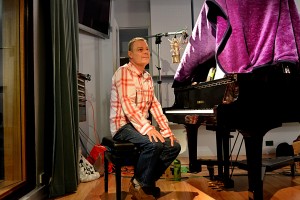
Part of the problem with recording this way is the distinct possibility that he may want to punch in part of his performance – particularly his vocal. So isolation between piano and vocal was particularly important, and we went to great lengths to achieve this. With the piano lid down, we were able to place our 3 microphones inside the piano, and then really “dress up” the instrument. We placed as many blankets and material on the piano as possible in the hope of isolating the piano away from the vocal.
The resultant sound was good. We used a Neumann U87 for his vocals, and utilised the mic’s standard pop filter. This pop filter, although not perfect, does a good job of removing plosives, while not being too visually obstructive.
For the piano we used my matched pair of Neumann KM184s over the hammers in an ORTF arrangement. In addition, an AKG414 was used at the very bottom of the piano near the bass strings, set to OMNI. This is my standard piano miking technique, although to be honest in recent times, I’ve been not quite so happy with the bottom mic. All three mics went into the standard Digidesign mic pre, but I also processed the bottom mic with some low pass filter to remove any top end in the sound. I was after bass!
The U87 vocal mic went into my favourite preamp – the Avalon 737. Some gentle, gentle, gentle compression applied (wouldn’t want all that piano coming through the vocal mic now, would we?), and some EQ to add tops and air. David has an amazingly “breathy” voice, and his phrases often end with more “breath” than “note” in a really interesting way. I wanted to capture that, and David often asks for it to be accentuated during mixdown.
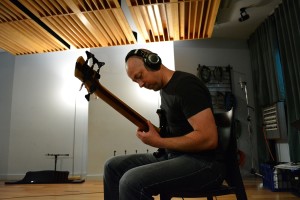
As a final set of mics for the piano I used a pair of AT4080 ribbon mics in the room. These are my current “room mic of choice”. I love the rounded tone of the ribbon, taking away some of the harsh brittleness so often heard on condenser mics.
Also recording at the same time was bass player Duncan Brown. He brought in this awesome DI made by Noble, worth some crazy amount like $1800 or something, and wanted to try it. Hey, I didn’t need to be asked twice. And WOW, what a sound. His DI went straight into another Avalon 737, with some gentle, gentle, gentle compression and then into Pro Tools. Sounded amazing, but as we all know, it’s actually all about the player as well. Duncan has a great feel and since he was in exactly the same room as David, they just locked on.
In a few takes we really had a good performance – musically. David was pretty happy with his vocal performance too, but we tried another version – without vocals this time. Within a few takes we had that too!
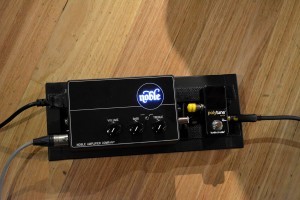
David then sat at the piano and added a vocal on top of the instrumental version. A few takes, a few drop ins and that was done too.
A week later, David came back into the studio for some percussion overdubs which were programmed in. The shakers were played in manually using Native Instruments Kontact, and some bells were added courtesy of Propellerhead Reason. It’d had been ages since I’ve used Reason, but man it was good to get back into it again. Later on I added some rainstick and belltree using Reason as well.
Given the sparse instrumentation, mixing was an uncluttered affair. See the screenshot…
The blue tracks at the top are my submix tracks. Generally I’m feeding the recorded audio into these tracks. There’s one for piano, vocals, bass, percussion, plus 2 reverb returns and a delay return.
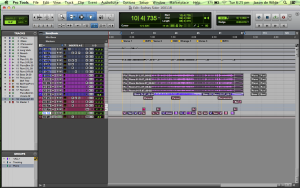 The piano submix has got the Focusrite D2 equaliser and that’s it. The bass submix has the most processing – Waves Guitar Stomp 2 (with a little bit of chorus), Waves Renaissance Axx, and again the Focusrite D2. Vocal submix has the Waves MV2 compressor, Waves Vitamin, and Waves H-Comp. The 2 reverb returns (one long, one medium) are through Native Instruments RC48, and AVID’s Reverb One. The Delay return is Waves H-Delay.
The piano submix has got the Focusrite D2 equaliser and that’s it. The bass submix has the most processing – Waves Guitar Stomp 2 (with a little bit of chorus), Waves Renaissance Axx, and again the Focusrite D2. Vocal submix has the Waves MV2 compressor, Waves Vitamin, and Waves H-Comp. The 2 reverb returns (one long, one medium) are through Native Instruments RC48, and AVID’s Reverb One. The Delay return is Waves H-Delay.
OK, ok, so I’m using a lot of Waves stuff. I don’t necessarily subscribe to it (yet) but I’ve just acquired the Waves Gold bundle, so I’m utilizing where I can!
The pink tracks are the recorded piano, which are then feeding the piano submix track at the top. The blue track is the recorded bass, and the red tracks are the recorded percussion and Reason. The green track is the recorded vocal. The Master buss at the bottom has Waves L1 + Ultramaximizer.
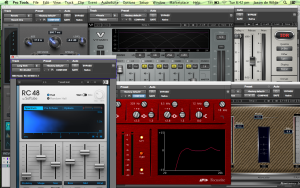 With most of my sessions recently, I’ve ventured into the high resolution sample rates of 96KHz. Maybe I’m dreaming, but for me there is an undeniably smooth detail and “air” that I’m loving with these higher rates. It just makes it fair more listenable!
With most of my sessions recently, I’ve ventured into the high resolution sample rates of 96KHz. Maybe I’m dreaming, but for me there is an undeniably smooth detail and “air” that I’m loving with these higher rates. It just makes it fair more listenable!
I’ve just finished the mix, and sent it to David, so awaiting feedback.
You must be logged in to post a comment.